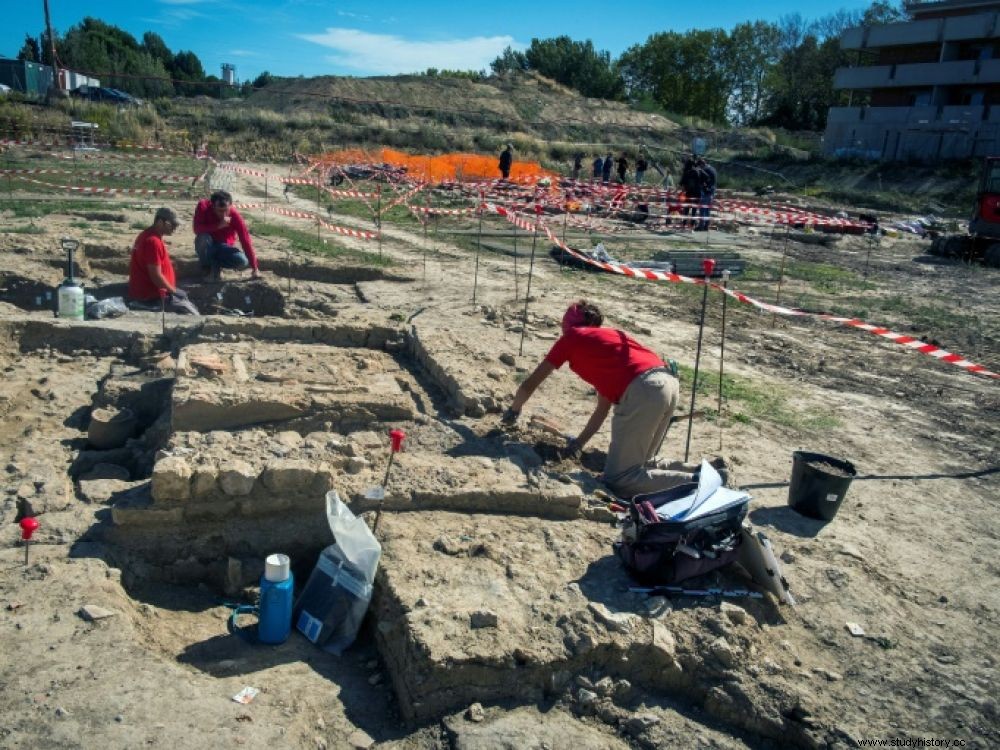The discovery in Narbonne, in Aude, of a Roman necropolis is unique in France.

Roman necropolis unearthed in Narbonne, October 7, 2019
"To Festus, 10, and Aquila, 8, Iulia Protogenia to her darlings" :nearly 2,000 years later, the discovery in Narbonne, in the Aude, of a Roman necropolis unique in France, brings out from the earth, as if intact, the pain of a Roman mother. Engraved on a marble slab, the funerary inscription is one of the first finds made by archaeologists on this site. Dating from the 1st to 3rd centuries, it is described as "exceptional" by Dominique Garcia, director of Inrap (National Institute for Preventive Archaeological Research).
Both by its size, nearly 5,000 m2 which could house up to a thousand graves, and by its state of conservation, thanks to the silts of an arm of the Aude which runs along it, and covered it when it was abandoned. ."This gives us a layered site, to a depth of up to 3m" , rejoices Valérie Bel, the director of the excavations. Thanks to this "millefeuille", which changes her from the "funds of tombs" that she usually searches, she hopes to be able to reconstruct the whole sequence of funeral practices.
According to Mr. Garcia, the necropolis suddenly offers a rare "panorama" of the rites, beliefs, and ways of being of the Romans then inhabiting Narbo Martius, the first Roman colony in Gaul, founded in 118 BC.
Snapshot of romanity
In a flourishing Upper Empire, the city was at the beginning of our era a major center of trade between the Mediterranean and the Atlantic. The Roman way of life and its rules are clearly drawn there, because they were established in a voluntary way, ex-nihilo, according to Mr. Garcia.
As evidenced by the tombs, the users of the necropolis did not belong to the elite. Many were freedmen and slaves, according to the indications provided by the epitaphs, notes Maxime Guillaume, from Inrap-Occitanie.
They had, however, achieved a certain social status, perhaps through trade. This, according to him, could be evidenced by the frequency of amphoras from Greece in the tombs.
Among the remains brought to light until then, the rarest are a series of "libation pipes", tubes often made up of fragments of amphoras, which the living used for their offerings to the dead, food, perfume, oil, even small objects.
On the site, one still stands, planted directly in a funerary urn, another emerges from the ground, indicating a tomb still inviolate. Further on, blackened stones are spread out in front of a tomb, the remains of a hearth lit, it looks like yesterday, for a funeral meal.
The tombs, of which a hundred have so far been excavated, are grouped, sometimes superimposed, within enclosures "of family groups or trades", notes the head of sector Marie Rochette. The ground is strewn with shells, testifying to food rituals.
A gift for the future museum
Sometimes surmounted by small monuments, most of the pits house funerary urns, cremation being then preferred, except for young children who were buried. To accompany the dead, a few terracotta vases, probably containing oil, a little food, perfume, sometimes one or two glass bottles, and oil lamps, "which corresponds to the rite said of inversion, marking the separation between day and night, life and death" , explains Ms. Bel.
A few amulets also sometimes, like a small gold phallic pendant. A terracotta baby bottle was also found.
The "funerary quarter" as archaeologists prefer to call it, to account for a more informal organization than our current cemeteries, was brought to light thanks to preventive excavations for the construction of a residence, on the outskirts of Narbonne. .
Initially scheduled to last four months, the site has been extended until the end of next summer, for a budget of six million euros, to match the interest of the site.
Especially since, by chance or "gift of the Gods" as an archaeologist would play, it adjoins the future museum that the region has decided to devote to the Roman Narbonnaise. The remains and information that it will deliver should enrich the collections, before it is returned to the promoters and covered.
